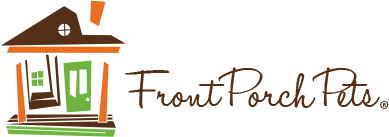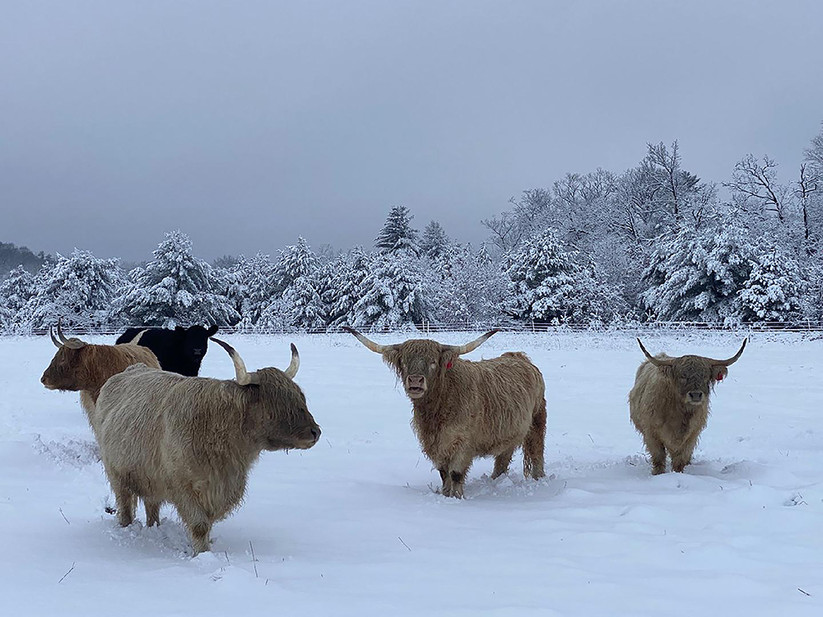The weather: Everyone’s favorite small talk subject! This week the buzz around the building is the upcoming Arctic Blast headed our way and a potential nasty snow storm just in time to ruin weekend travel plans. Temperatures have already started to drop and the low tonight will be below zero. It’s a great time of year to be cozied up inside near the wood stove with slippers, a steaming cup of herbal tea, and my two furry housemates. I have a spoiled springer spaniel and an older rescue cat that likes to brave the outdoors in approximately 30-second intervals. For those critters that aren’t so fortunate to be indoors on these frigid winter nights, we do everything we can to ensure that they can brave the weather.
First and foremost, all of the breeds of animals on the farm have been chosen to be able to withstand harsh Wisconsin winters. Our cows are Scottish Highlands, Belted Galloways, and sometimes a mix of the two. Both are old breeds originating in the windy, damp and cold coastal region of Scotland. They have an undercoat for insulation and a shaggy oily outercoat to shed rain and snow. After a particularly sticky snowfall, sometimes a layer of snow can be seen on the cows’ backs. This is a good indicator of just how well the cows are able to keep their body heat in. A little fat is also beneficial. Our cows do not receive daily rations but rather have access to several hay bales at a time to eat to their hearts’ content. Having several bales to choose from also reduces food competition among the herd. This is especially helpful for Althea, our nearly blind, beloved strawberry blonde highland who is prone to being pushed around by the bossy herd mates. An automatic heated waterer, a modest shelter with a windbreak, a buffet of 20 different vitamins and minerals, and plenty of sweet potato treats round out the complete care for our fuzzy cows. They remain quite content all winter long and make wonderful photography subjects against a background of snowy trees.
Not as well-suited for winter is our flock of egg-laying chickens. This year our pampered crew of 40 hens and 6 roosters were the lucky recipients of a brand new greenhouse-type structure. It is large and sunny and marvelous! While the temperature outside didn’t even reach 20 degrees today, I had to remove my jacket while working inside the hen house. It was 75 degrees just from capturing the sun’s rays. The whole flock was either contentedly sun-bathing or happily scratching through the leaves covering the floor looking for missed treats. Special treats in the wintertime are a must! These spoiled birds get sprouted seeds daily, mealworms that I grow in my office, and sometimes even scrambled eggs with beneficial herbs for an extra protein boost. I’m a big fan of unpasteurized apple cider vinegar in their water as well. Studies show it supports a healthy gut biome.
Last but not least is our misfit crew of yardbirds. Currently we have 2 Chinese geese, 11 ducks, 2 turkeys, and 2 stubborn hens. They have access to a large yard area and 2 spacious shelters lined with dry fluffy straw. Oddly enough, the ducks and geese prefer to hang out under a big drooping ornamental bush. I will try to usher them into one of the sheds for this particular cold stretch but something tells me they’re not going to like it! Like their wild cousins, ducks and geese have special adaptations to help them retain their body heat on these bitter days. In addition to thick downy feathers and a layer of fat, countercurrent heat exchange ensures they don’t get frostbitten feet. Simply put, the warm blood traveling to their feet heats the cool blood that is traveling back from their feet. While this is a special trait specific to waterfowl, our pair of turkeys do just fine with the winter temperatures as well. Our turkeys are a heritage breed called bourbon reds. They are much more closely related to native wild turkeys than the standard broad-breasted meat variety that you’d find on a commercial turkey farm. With their strong natural instincts, their favorite place to shelter is in a bushy pine tree directly above the man-made shelters. On the chilliest days they will stay in the tree until weather conditions become more favorable. All of our yardbirds enjoy many of the same treats as the laying hens in addition to leftover lettuce from the staff salad bar. Two feeders in the yard filled with high-quality feed ensure that everyone maintains their cozy fat layer.
Though winter is not a pleasant time of the year for many, I’m convinced that the rest and reflection that comes with the season is profound. Warmer, brighter days will be here before we know it and in the meantime, I can rest easy knowing that all of our cherished livestock are cared for to the best of my ability and well-equipped for whatever Mother Nature has in store.

